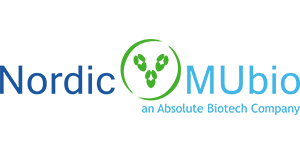Mouse anti Tenascin C
Mouse anti Tenascin C, IgG1, Clone: T2H5
SKU
NORMUB2028P
Packaging Unit
0,1mg
Manufacturer
Nordic-MUbio
Availability:
loading...
Price is loading...
Clone: T2H5
Background: Tenascin is a high molecular weight, multifunctional, extracellular matrix glycoprotein expressed in association with mesenchymal-epithelial interactions during development. It has been described under a variety of names, i.e. cytotactin, hexabrachion protein, J1, myotendinous antigen and glioma mesenchymal extracellular matrix. In undifferentiated tumors it is also detectable in the neovasculature and stroma. The tenascin molecule is a disulfide-linked hexamer. The expression of tenascin is associated with development and growth, both normal and pathological, whereas the distribution in normal adult tissue is restricted. For example, this extracellular matrix protein is implicated in guidance of migrating neurons as well as axons during neural development as well as neuronal regeneration. In in vitro studies it promotes neurite outgrowth from cortical neurons grown on a monolayer of astrocytes. The cellular ligands for tenascin include integrins alpha-8/beta-1, alpha-9/beta-1, alpha-V/beta-3 and alpha-V/beta-6.
Source: T2H5 is a mouse monoclonal IgG1 antibody derived by fusion of mouse myeloma cells with spleen cells from a BALB/c mouse immunized with full length native tenascin protein purified from a homogenate of a human mammary tumour specimen.
Specificity: In immunoblotting assays on an extract of a human osteosarcoma cell line (U2OS) T2H5 recognizes a 265 kDa protein. Tenascin C contains an exstensive number of potential glycosylation sites, which may explain its migration at a higher molecular weight than predicted. Human tonsilar tissue can be used as a positive control in immunocytochemistry and immunohistochemistry.
Formulation: Each vial contains 100 µl 1 mg/ml purified monoclonal antibody in PBS containing 0.09% sodium azide.
References: 1. Tokes AM, Hortovanyi E, Csordas G, Kulka J, Mozes G, Hatalyak A, Kadar A: Immunohistochemical localisation of tenascin in invasive ductal carcinoma of the breast. Anticancer Res. 1999;19:175-179.2. Faustino AM, van Garderen E, Schalken JA, Nederbragt H: Tenascin expression in normal, hyperplastic, dysplastic and neoplastic canine mammary tissues. J Comp Pathol. 2002;126:1-8. 3. Gulubova M: Immunohistochemical localization of collagen type III and type IV, laminin, tenascin and alpha-smooth muscle actin (alphaSMA) in the human liver in peliosis. Pathol Res Pract. 2002;198:803-812. 4. Ioachim E, Charchanti A, Briasoulis E, Karavasilis V, Tsanou H, Arvanitis DL, Agnantis NJ, Pavlidis N: Immunohistochemical expression of extracellular matrix components tenascin, fibronectin, collagen type IV and laminin in breast cancer: their prognostic value and role in tumour invasion and progression. Eur J Cancer. 2002;38:2362-2370.5. Singh SR, Billington CK, Sayers I, Hall IP. Can lineage-specific markers be identified to characterize mesenchyme-derived cell populations in the human airways? Am J Physiol Lung Cell Mol Physiol. 2010;299:L169-183.
UniProt: P24821
Background: Tenascin is a high molecular weight, multifunctional, extracellular matrix glycoprotein expressed in association with mesenchymal-epithelial interactions during development. It has been described under a variety of names, i.e. cytotactin, hexabrachion protein, J1, myotendinous antigen and glioma mesenchymal extracellular matrix. In undifferentiated tumors it is also detectable in the neovasculature and stroma. The tenascin molecule is a disulfide-linked hexamer. The expression of tenascin is associated with development and growth, both normal and pathological, whereas the distribution in normal adult tissue is restricted. For example, this extracellular matrix protein is implicated in guidance of migrating neurons as well as axons during neural development as well as neuronal regeneration. In in vitro studies it promotes neurite outgrowth from cortical neurons grown on a monolayer of astrocytes. The cellular ligands for tenascin include integrins alpha-8/beta-1, alpha-9/beta-1, alpha-V/beta-3 and alpha-V/beta-6.
Source: T2H5 is a mouse monoclonal IgG1 antibody derived by fusion of mouse myeloma cells with spleen cells from a BALB/c mouse immunized with full length native tenascin protein purified from a homogenate of a human mammary tumour specimen.
Specificity: In immunoblotting assays on an extract of a human osteosarcoma cell line (U2OS) T2H5 recognizes a 265 kDa protein. Tenascin C contains an exstensive number of potential glycosylation sites, which may explain its migration at a higher molecular weight than predicted. Human tonsilar tissue can be used as a positive control in immunocytochemistry and immunohistochemistry.
Formulation: Each vial contains 100 µl 1 mg/ml purified monoclonal antibody in PBS containing 0.09% sodium azide.
References: 1. Tokes AM, Hortovanyi E, Csordas G, Kulka J, Mozes G, Hatalyak A, Kadar A: Immunohistochemical localisation of tenascin in invasive ductal carcinoma of the breast. Anticancer Res. 1999;19:175-179.2. Faustino AM, van Garderen E, Schalken JA, Nederbragt H: Tenascin expression in normal, hyperplastic, dysplastic and neoplastic canine mammary tissues. J Comp Pathol. 2002;126:1-8. 3. Gulubova M: Immunohistochemical localization of collagen type III and type IV, laminin, tenascin and alpha-smooth muscle actin (alphaSMA) in the human liver in peliosis. Pathol Res Pract. 2002;198:803-812. 4. Ioachim E, Charchanti A, Briasoulis E, Karavasilis V, Tsanou H, Arvanitis DL, Agnantis NJ, Pavlidis N: Immunohistochemical expression of extracellular matrix components tenascin, fibronectin, collagen type IV and laminin in breast cancer: their prognostic value and role in tumour invasion and progression. Eur J Cancer. 2002;38:2362-2370.5. Singh SR, Billington CK, Sayers I, Hall IP. Can lineage-specific markers be identified to characterize mesenchyme-derived cell populations in the human airways? Am J Physiol Lung Cell Mol Physiol. 2010;299:L169-183.
UniProt: P24821
| SKU | NORMUB2028P |
|---|---|
| Manufacturer | Nordic-MUbio |
| Manufacturer SKU | MUB2028P |
| Package Unit | 0,1mg |
| Quantity Unit | STK |
| Reactivity | Human |
| Clonality | Monoclonal |
| Application | Immunohistochemistry (frozen), Immunohistochemistry (paraffin), Immunoprecipitation, Western Blotting, Immunocytochemistry |
| Isotype | IgG1 |
| Host | Mouse |
| Conjugate | Unconjugated |
| Product information (PDF) | Download |
| MSDS (PDF) | Download |

 Deutsch
Deutsch







